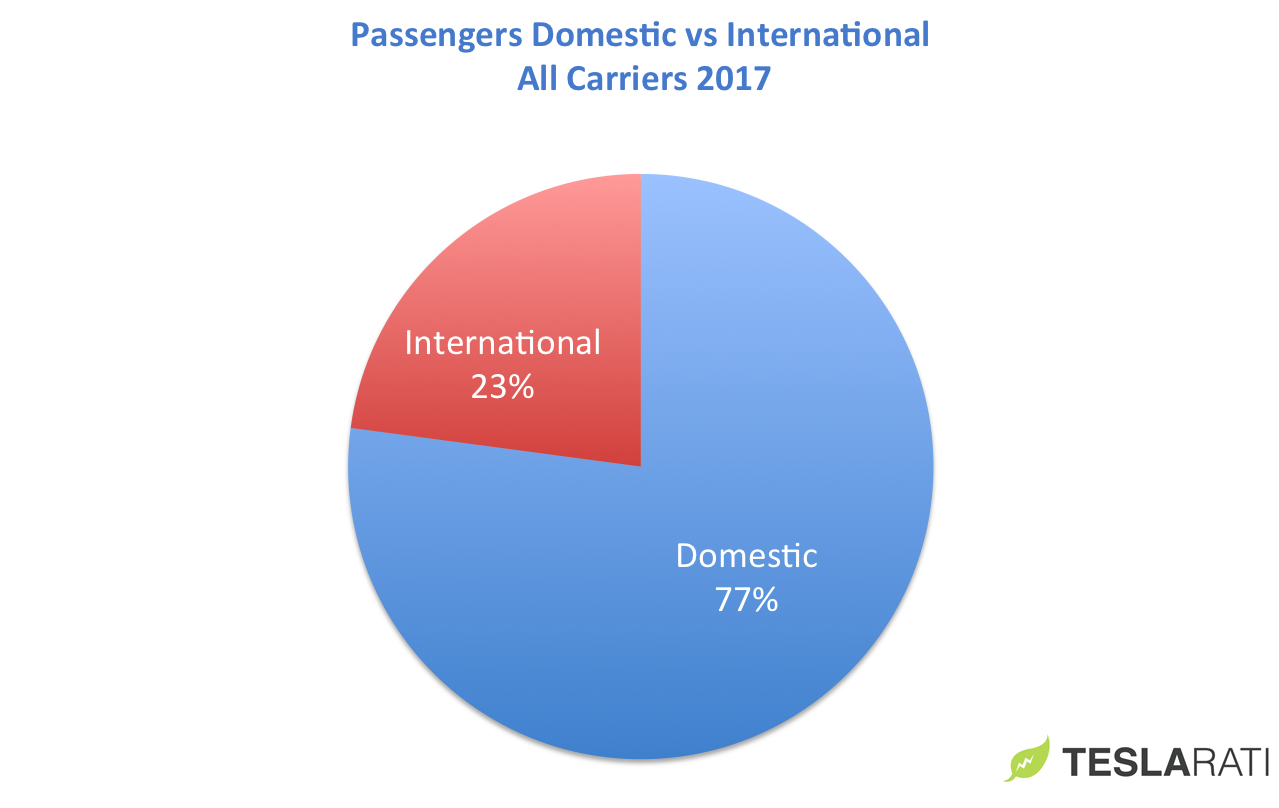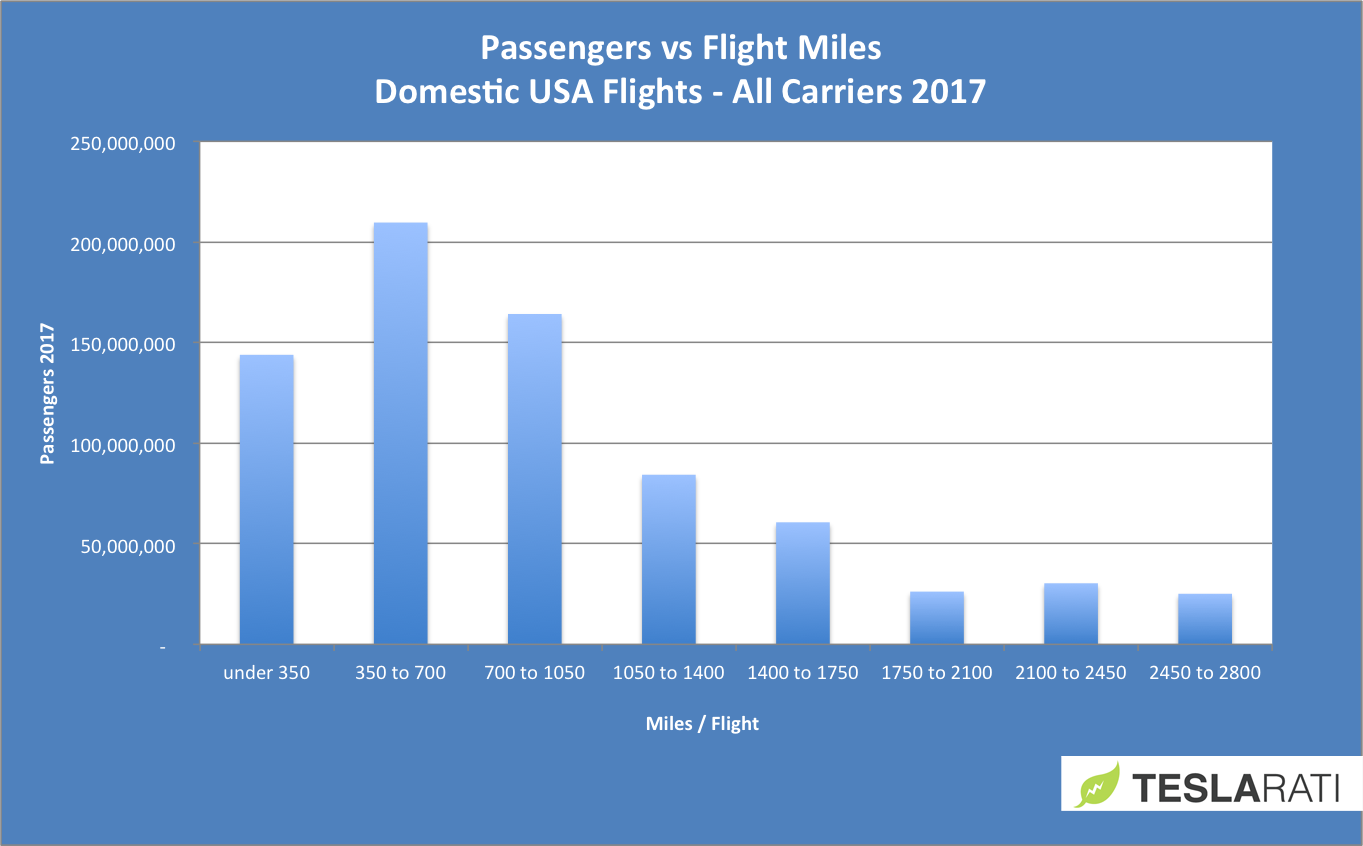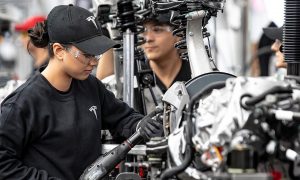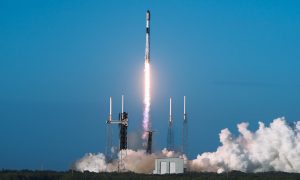

News
Electric aircraft could transform short-distance regional air travel
Whenever the subject of electric aircraft comes up I see the room filled with skeptical looks. The looks are not unwarranted. Even electric cars remain in the low single digits for worldwide market share and electric flight is undoubtedly a greater hurdle. The enemy of flight is weight after all and batteries are rather heavy. The skepticism though, while justified, is misplaced.
The problem is that we tend to think of air transport as large intercontinental craft flying thousands of miles at a time. Those certainly exist and there’s even one that travels 9000 miles, flying 17 hours from Perth to London. The reality for most air travel, however, is somewhat different. Statistics from the US Bureau of Transportation show that the overwhelming majority of US passengers are on domestic flights and what’s more, nearly half of those are under 700 miles.
Source: Bureau of Transportation Statistics – T100 domestic, all carriers

The data graphed above shows that 20% of domestic passengers are flying under 350 miles in the USA, with nearly 50% under 700 miles. Forget about the 9,000 mile international flights, this is the market for electrified flight in the near-term. The aircraft to support it are nearly here.
I’ve written in the past about the various electric aircraft in development from companies like Zunum Aero, Wright Electric, Airbus/Siemens, NASA, Eviation, BYE, and others. It’s still very early but advancement is steady and the age of electric flight is coming. For a moment consider Zunum Aero’s aircraft, the ZA10. It’s a 12-seat hybrid for regional transport, slated to begin test flights next year and deliveries in the early 2020s. The aircraft is targeting a range of 700 miles and will have a shorter range all-electric version. There’s also a larger variant planned.
Zunum Aero’s ZA10

- 60 to 80% reduction in operating costs
- 80% lower emissions and noise
- 40% reduction in runway needs
- Hybrid-electric range of 700 miles
Back to those skeptical looks. The financial driver for electrification is huge, with the potential to reduce operating costs 60 to 80%. More so with carbon pricing. If said hybrid aircraft also create less pollution, require shorter runways, reduce maintenance, and produce less noise, well then which carriers wouldn’t want to use them? Particularly in a regional market which, as noted previously, includes nearly 50% of all domestic flights in the US.
That all seems great, but even this understates the impact of electrification. What’s missing from the analysis is the potential for electric aircraft to fundamentally transform air travel as we know it, to vastly increase the number of flights under 700 miles.
The data we have today shows us the past, but this is the future:
Electric and hybrid aircraft have the potential to open up new regions to air travel, revitalize small neglected airports, create jobs in small communities, and make travel more enjoyable for everyone. This vision will become a necessity if we hope to have a cohesive society and growing economy,
“In the globalized economy, communities without good air service struggle to attract investment and create jobs” – Zunum Aero
There’s a wonderful write-up on IEEE Spectrum which highlights how electrification can be the catalyst that rejuvenates regional travel. The article’s authors are from Zunum Aero, including the founder and the chief technology officer.
The article includes some interesting statistics on the current state of air travel. For example, the authors note that only 1% of the airports in the USA are responsible for 96% of the air traffic and that since 1980 the average aircraft seat capacity has increased by a factor of 4. What if electric aircraft can increase travel to just some of those other airports?
The current state of air travel is largely the result of financial choices made over many decades. Larger aircraft are more economical to purchase and operate, while fewer routes keep aircraft load factors high and simplifies logistics.
“Regional Travel is Ripe for Reinvention” – JetBlue Technology Ventures
The problem with this is that large airplanes require large infrastructure to support them (think space, buildings, runways) and the noise they generate is not well liked by residents. There aren’t many airports able to accommodate these needs so people are funneled to major airports located outside of major cities, sometimes inconveniently out of the way of the passengers’ ultimate destinations. This means more time is spent traveling to the airport, at the airport, and flying on the airplane, for an experience that is all to often chaotic and impersonal. In fact, door to door travel times have actually gotten worse for regional air travel, not better. Add in a snowstorm or a single large aircraft is delay and it can become a logistical nightmare.
The benefits of electric aircraft are particularly well suited to regional air travel needs. The question is, will it be enough to usher in a renaissance for regional flight, where smaller aircraft travel more routes and to smaller airports? I certainly think so. Toronto has a great example of how this might occur. The Toronto Island airport can only operate small aircraft due to noise restrictions, but it’s use has grown steadily. It’s accessibility from downtown and the spectacular speed of service are key drivers. With electric aircraft I believe this type of scenario will become the norm.
Now, what if you could do it from your own front door?
Hyper-local air travel with electric vertical takeoff and landing aircraft (E-VTOL)
Imagine this. You wake up in the morning, dress, open your phone and request an electric vertical takeoff and landing aircraft (VTOL) to take you to a city a few hours drive away. An electric autonomous car picks up you and drives you to a local VTOL access point, on top of a parkade near your home. Several small two and four seat aircraft are waiting there. Maybe someone is there to greet you but it’s only customary. Your phone recognizes your access and opens up the passenger compartment to your aircraft. You get in, there is no pilot, no cockpit – the vehicle is autonomous. Quickly the electric motors spin up, the craft rises into the air and carries you directly into the centre of a nearby city. Or maybe you go to a remote campsite or to an airport outside of the city where you can access an intercontinental flight. All of this for a cost less than traditional means of transport.
Long have we been promised a future of flying cars, but this time electric propulsion and increased autonomy can actually make it happen. Check out the video below of the first full scale test flight of the Lilium Jet in 2017. Such ideas were once confined to science fiction, but no more. Yes, this technology is in the early stages and it remains to be seen how far batteries can take us. Yet those batteries get better each year. For Lilium’s part they have manned test flights coming next year and they are targeting a range of 300km and speed of 300km/hr. That could open up a whole new type of air travel.
Electric VTOL – Lilium
Lilium started in 2013 with the vision of developing an all-electric “air-taxi” vehicle.
There are now dozens of companies working on electric VTOL aircraft, with over 100 projects underway. Norway’s aircraft operator Avinor even issued a report earlier this year that sees a path to small VTOL aircraft with 1 or 2 passengers in the early to mid 2020’s, with larger 4 or 5 person craft reaching market by the end of the 2020’s.
The fascinating world of VTOLs aside, fixed-wing hybrid and electric regional jets provide an obvious path for electrification. This will reduce operating costs, open up new opportunities for passengers, and reduced the environmental impact of flying. It’s where corporations and countries are already going. Norway for example has a target of 2030 for all regional flights to be fully electric, not hybrid, fully electric. While operators and manufacturers are pushing to see who can take the lead. One thing is certain, with the coming advancements in electric flight regional transport will never be the same.
Elon Musk
Tesla reveals it is using AI to make factories more sustainable: here’s how
Tesla is using AI in its Gigafactory Nevada factory to improve HVAC efficiency.

Tesla has revealed in its Extended Impact Report for 2024 that it is using Artificial Intelligence (AI) to enable its factories to be more sustainable. One example it used was its achievement of managing “the majority of the HVAC infrastructure at Gigafactory Nevada is now AI-controlled” last year.
In a commitment to becoming more efficient and making its production as eco-friendly as possible, Tesla has been working for years to find solutions to reduce energy consumption in its factories.
For example, in 2023, Tesla implemented optimization controls in the plastics and paint shops located at Gigafactory Texas, which increased the efficiency of natural gas consumption. Tesla plans to phase out natural gas use across its factories eventually, but for now, it prioritizes work to reduce emissions from that energy source specifically.
It also uses Hygrometric Control Logic for Air Handling Units at Giafactory Berlin, resulting in 17,000 MWh in energy savings each year. At Gigafactory Nevada, Tesla saves 9.5 GWh of energy through the use of N-Methylpyrrolidone refineries when extracting critical raw material.
Perhaps the most interesting way Tesla is conserving energy is through the use of AI at Gigafactory Nevada, as it describes its use of AI to reduce energy demand:
“In 2023, AI Control for HVAC was expanded from Nevada and Texas to now include our Berlin-Brandenburg and Fremont factories. AI Control policy enables HVAC systems within each factory to work together to process sensor data, model factory dynamics, and apply control actions that safely minimize the energy required to support production. In 2024, this system achieved two milestones: the majority of HVAC infrastructure at Gigafactory Nevada is now AI-controlled, reducing fan and thermal energy demand; and the AI algorithm was extended to manage entire chiller plants, creating a closed-loop control system that optimizes both chilled water consumption and the energy required for its generation, all while maintaining factory conditions.”
Tesla utilizes AI Control “primarily on systems that heat or cool critical factory production spaces and equipment.” AI Control communicates with the preexisting standard control logic of each system, and any issues can be resolved by quickly reverting back to standard control. There were none in 2024.
Tesla says that it is utilizing AI to drive impact at its factories, and it has proven to be a valuable tool in reducing energy consumption at one of its facilities.
Elon Musk
Tesla analysts believe Musk and Trump feud will pass
Tesla CEO Elon Musk and U.S. President Donald Trump’s feud shall pass, several bulls say.

Tesla analysts are breaking down the current feud between CEO Elon Musk and U.S. President Donald Trump, as the two continue to disagree on the “Big Beautiful Bill” and its impact on the country’s national debt.
Musk, who headed the Department of Government Efficiency (DOGE) under the Trump Administration, left his post in May. Soon thereafter, he and President Trump entered a very public and verbal disagreement, where things turned sour. They reconciled to an extent, and things seemed to be in the past.
However, the second disagreement between the two started on Monday, as Musk continued to push back on the “Big Beautiful Bill” that the Trump administration is attempting to sign into law. It would, by Musk’s estimation, increase spending and reverse the work DOGE did to trim the deficit.
Every member of Congress who campaigned on reducing government spending and then immediately voted for the biggest debt increase in history should hang their head in shame!
And they will lose their primary next year if it is the last thing I do on this Earth.
— Elon Musk (@elonmusk) June 30, 2025
President Trump has hinted that DOGE could be “the monster” that “eats Elon,” threatening to end the subsidies that SpaceX and Tesla receive. Musk has not been opposed to ending government subsidies for companies, including his own, as long as they are all abolished.
How Tesla could benefit from the ‘Big Beautiful Bill’ that axes EV subsidies
Despite this contentious back-and-forth between the two, analysts are sharing their opinions now, and a few of the more bullish Tesla observers are convinced that this feud will pass, Trump and Musk will resolve their differences as they have before, and things will return to normal.
ARK Invest’s Cathie Wood said this morning that the feud between Musk and Trump is another example of “this too shall pass:”
BREAKING: CATHIE WOOD SAYS — ELON AND TRUMP FEUD “WILL PASS” 👀 $TSLA
She remains bullish ! pic.twitter.com/w5rW2gfCkx
— TheSonOfWalkley (@TheSonOfWalkley) July 1, 2025
Additionally, Wedbush’s Dan Ives, in a note to investors this morning, said that the situation “will settle:”
“We believe this situation will settle and at the end of the day Musk needs Trump and Trump needs Musk given the AI Arms Race going on between the US and China. The jabs between Musk and Trump will continue as the Budget rolls through Congress but Tesla investors want Musk to focus on driving Tesla and stop this political angle…which has turned into a life of its own in a roller coaster ride since the November elections.”
Tesla shares are down about 5 percent at 3:10 p.m. on the East Coast.
Elon Musk
Tesla scrambles after Musk sidekick exit, CEO takes over sales
Tesla CEO Elon Musk is reportedly overseeing sales in North America and Europe, Bloomberg reports.

Tesla scrambled its executives around following the exit of CEO Elon Musk’s sidekick last week, Omead Afshar. Afshar was relieved of his duties as Head of Sales for both North America and Europe.
Bloomberg is reporting that Musk is now overseeing both regions for sales, according to sources familiar with the matter. Afshar left the company last week, likely due to slow sales in both markets, ending a seven-year term with the electric automaker.
Tesla’s Omead Afshar, known as Elon Musk’s right-hand man, leaves company: reports
Afshar was promoted to the role late last year as Musk was becoming more involved in the road to the White House with President Donald Trump.
Afshar, whose LinkedIn account stated he was working within the “Office of the CEO,” was known as Musk’s right-hand man for years.
Additionally, Tom Zhu, currently the Senior Vice President of Automotive at Tesla, will oversee sales in Asia, according to the report.
It is a scramble by Tesla to get the company’s proven executives over the pain points the automaker has found halfway through the year. Sales are looking to be close to the 1.8 million vehicles the company delivered in both of the past two years.
Tesla is pivoting to pay more attention to the struggling automotive sales that it has felt over the past six months. Although it is still performing well and is the best-selling EV maker by a long way, it is struggling to find growth despite redesigning its vehicles and launching new tech and improvements within them.
The company is also looking to focus more on its deployment of autonomous tech, especially as it recently launched its Robotaxi platform in Austin just over a week ago.
However, while this is the long-term catalyst for Tesla, sales still need some work, and it appears the company’s strategy is to put its biggest guns on its biggest problems.
-

 Elon Musk1 day ago
Elon Musk1 day agoTesla investors will be shocked by Jim Cramer’s latest assessment
-

 News6 days ago
News6 days agoTesla Robotaxi’s biggest challenge seems to be this one thing
-

 News2 weeks ago
News2 weeks agoTesla’s Grok integration will be more realistic with this cool feature
-

 Elon Musk2 weeks ago
Elon Musk2 weeks agoElon Musk slams Bloomberg’s shocking xAI cash burn claims
-

 News2 weeks ago
News2 weeks agoTesla China roars back with highest vehicle registrations this Q2 so far
-

 News2 weeks ago
News2 weeks agoTexas lawmakers urge Tesla to delay Austin robotaxi launch to September
-

 News2 weeks ago
News2 weeks agoTesla dominates Cars.com’s Made in America Index with clean sweep
-

 Elon Musk1 week ago
Elon Musk1 week agoFirst Look at Tesla’s Robotaxi App: features, design, and more




















